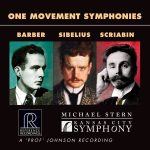|
Back
07/01/2021
“One Movement Symphonies”
Samuel Barber: First Symphony (In One Movement), opus 9
Jean Sibelius: Symphony n° 7 in C major, opus 105
Alexander Scriabin: Le Poème de l’extase (The Poem of Ecstasy), opus 54
Kansas City Symphony, Noah Geller (concertmaster), Michael Stern (conductor)
Recording: Helzberg Hall, Kauffman Center for the Performing Arts, Kansas City, Missouri (June 24-25, 2016) – 62’28
Reference Recordings RR-149 (Distributed by Naxos of America) – Booklet in English

   
Michael Stern leads the Kansas City Symphony (KCS) in a new recording of single movement symphonies by Samuel Barber, Jean Sibelius and Alexander Scriabin. Each of these stylistically different composers solves the challenges this form would inherently present, and each proves it to be a liberating and artistically durable form for their eras.
Barber and Sibelius, particularly well-known for their most famous pieces, Adagio for Strings and Finlandia, respectively, are audience favorites and in heavy rotation on the concert stage and on recordings by orchestras all over the world. But, of course, in all three cases, their large body of works deserve equal attention. Scriabin is known for his brilliant piano pieces, while his orchestral works have been largely ignored.
The recording opens with Barber’s First Symphony (In One Movement), opus 9 which showcases Barber’s instant technical ‘synthetic’ structural elements of a four-movement symphony (in this case modeled after Sibelius’ Symphony n° 7) into a single cohesive arc.
Conductor Michael Stern’s exquisite pacing in this performance points up the specificness of Barber’s command of the concept. Beyond the technical aspects, it is Barber at his most lyrically dramatic. Barber was just 26 when he composed this work, and in retrospect it strikes as mature and foreshadows many of his later chamber and operatic signatures. Barber’s oceanic strings and coloratura brass find the composer at his most dramatically lyrical best, here brought to its full impact by the KCS. Composed in the same year was his most famous work, Adagio for Strings (originally the second movement of his String Quartet, opus 11). It was one of his most creative periods while he was in Italy with Gian Carlo Menotti, his lover, and Barber dedicated his First Symphony to him.
Jean Sibelius’ Symphony n° 7 in C major, opus 105, composed in 1924 was based on sonata forms and applied to the composer’s neo-romantic style. Sibelius, at age 60, was struggling in 1924, and it was his last symphonic work. Its opening passages have a radiant meditative quality that gives way to the slow approach of a sonic build that is vintage Sibelius. It was his last symphony. The orchestral progression still captivates in its dramatic impact. Stern’s balance of Sibelius’ full dimension of sound, without leaning on its sonic drama, is masterful, crucially not defusing the chamber music intimacy of the piece.
Alexander Scriabin’s Le Poème de l’extase (The Poem of Ecstasy, opus 54, composed in 1905-1908, the years after he left his six-years as professor at the Moscow Conservatory as noted in the CD book notes, was a job he found ‘painful’. Scriabin abandoned teaching for composition and performing piano recitals on tour. His music is imbued with his aesthetic interest in philosophy and mysticism, and he liberated conventional musical structure of the Russian schools with his own enlightened ideas that makes this a visionary composition. It also strikes one as fusionist expressionism, especially in the opening charts that even has Debussyian illusory luster. Deeper into the symphony a dominant violin line and fiery brass heralds prompt Scriabin’s Russian orchestral signatures which could be mistaken for a preamble to Stravinsky’s 1910 ballet score to The Firebird. The intoxicating sound in this rarely performed work is fully realized by the KCS.
Capturing the scale and subtleties of the KCS performances of these symphonies in a two-day session June 24-25, 2016 were engineers Keith O. Johnson and Sean Royce Martin. GRAMMY © award-winning and nominated Johnson is one of the founders of Reference Recordings. Martin has also received four GRAMMY © nominations for Engineering.
Lewis J. Whittington
|